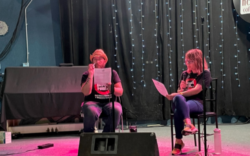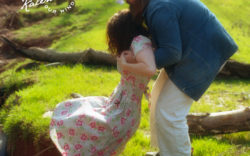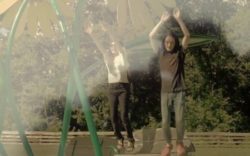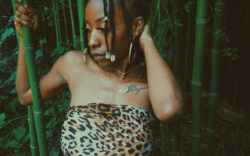I have to keep buying more iCloud storage simply for the pictures. Stacks of Polaroids litter the top of my dresser. Boxes of them are stashed in storage bins. Sometimes I become self-conscious when I notice how often I pull up my camera app around others or how ridiculous it is that I bring my Fujifilm Instax Mini to indoor places that aren’t conducive to the necessary flash. I’m self-conscious for only a moment because I soon acknowledge that photographs are frozen moments in time, forever existing in some digital or tangible form.
Magic resides in photographs, especially for a person with a terrible memory like my own. They remind me that I actually saw that sunset, that waterfall, that mountain range, those favorite musicians of mine—especially the music. My Instagram posts are sprinkled with blue and violet hues from the stage lights at live music performances. “Ah, yes. I remember—I was there in front of them swaying, jumping with everyone around me to those nostalgic songs.” During these pandemic times, where live shows lie sleeping, I’ve often resurfaced the music footage that I’ve taken. I once thought that the footage is simply a hoarder’s fancy, never to be looked at, simply stored for comfort, as if my memory exists if, and only if, the material exists.
However, in the aching absence of live music, every captured performance that I went through operated as a portal. Those photographs and clips brought me back—back to the very day I saw Turnover with my mom, where she hooted and hollered louder than I did; I was taken back to the greatest days with my best friends, where we danced to music from Band of Horses, The Growlers, The Flaming Lips, a multitude of other bands; I was taken back to the days where I went to shows alone, feeling fundamentally connected, empowered, full. Reflection has been vital during this time of uncertainty, and those frozen moments are an important tool. This leads me to believe that taking a picture is a powerful act because of its successive reflection. This leads me to believe in photography’s gravitational capabilities, not just for the individual but also for a unified whole.
Music photography is the documentation of a universal language that carries people and movements through time. There are no words to be read, like lyrics on the internet, but the 1000-word cliché is there in these moments, inside and outside the venue. Photographs are a personal record and, once shared, a public one. Photography strengthens community through this shared memory—“If we take a picture of another person, we pose them in exteriority—exposing them to the gaze of others and to themselves as other. In this way, we open up a space of communication and of emotional connection,” wrote University of Toronto Mississauga photography professor Louis Kaplin in his journal article. The people pointing and shooting—sometimes allowed, sometimes not—elevate particular messages through artful, conscious decisions. Photography is history in the making, illustrating social, cultural and political transformations for the self and for the collective.
Capturing the Human
Sue Myers Smith values the personal record she creates with her photography. Smith is the public relations manager for the University of Georgia (UGA) Center for Continuing Education & Hotel and uses photography to promote the Center and its events, among other responsibilities in her multipurpose role. Outside of public relations and marketing for UGA, she freelances and photographs her husband’s band, Theocracy, a Christian progressive-power-metal band.
Smith started experimenting with photography when she was 11 years old. She got her hands on her dad’s heavyweight 35-millimeter single-lens-reflex camera from the ‘60s and strove to make the camera do what she saw. Smith said she was always observant, picking up the details that others failed to see. Theocracy’s most popular pictures on social media were of the band off-stage.
At shows, concerts and festivals, there’s often a physical barrier between the artist and the audience, a raised stage or gate, but there’s also an invisible barrier of status, strengthened by their fame or a deep love for the talented, placing them on a pedestal. Capturing those moments off-stage, where musicians are portrayed at eye-level with the fans, breaks down that barrier and invokes a greater relationship. “It’s like, ‘Oh, they’re real people,’” Smith said.
As it is for Smith, capturing the vulnerable moments is important for Nolan Terrebonne, another freelance photographer based in Athens. Terrebonne was featured in a music photography exhibition at the tiny ATH gallery earlier this year. The exhibition showcased Athens-based photographers, musicians and venues. Terrebonne had only pursued paid photography work in the past 10 years but has been a hobbyist as long as he’s been active in music. He’s been a musician for 21 years, spending some of that time playing with national-touring band Planet Jive and regional-touring act SHOWTIME. He also owned TNEB-RCP MUSIC GROUP, a small, independent label, and co-owned Odd Squad Studios, a recording studio.
With bigger concerts, there’s dozens of photographers on the scene, and that’s why Terrebonne stresses an all-access pass at any gig. “I’ll take a cut in pay on that shit. Why? Because I get to hang out with these guys and be a fly on the wall, just being in the shadows, not interrupting their energy and whatever emotions they got going on.” Music photography has a strong emotional component, communicated through the energy on stage and an onlooking sea of heads, but humanizing them is part of the work.
“As soon as they spot you and put on that rock-star attitude, it’s over,” Terrebonne said. It’s those moments “when somebody is playing something, they might have a lyric in their head or that moment—maybe something happened that day on the way to the show. You look over and that one person has that look on their face and that aura around him, that ‘I’m not paying attention to anything else around me right now.’ I’m doing those.” His favorite shots are of musicians’ solemn faces in the midst of rock-show chaos.
Sneaking the Picture

UGA photography professor Kyser Lough thumbed through the shelf full of books on photography in his office. Lough—a tall guy with glasses, a goatee and a nearly bald head—was excited to hand over a book titled, No Cameras Allowed: My Career as an Outlaw Rock and Roll Photographer, 1981-1987. Through words and photographs author Julian Stone and friend of Lough, talks about his rebel act of sneaking camera equipment into concerts. Preceding Stone were photographers like Ross Haflin, who’s been the official tour photographer for big-name acts like Paul McCartney and The Who. Haflin fell into music photography “almost by accident” by pirating camera equipment, according to his website.
“The artist is putting on a performance, and there’s only two ways to capture that: a film or a photograph—and that facilitates them getting their message out,” Stone said. “How else is an image memorialized?”
Photography has the capacity to encapsulate an issue. “Photographs furnish evidence,” wrote Aaron Meskin and Jonathan Cohen, philosophy professors at UGA and the University of California, San Diego, respectively. In their journal article, Meskin and Cohen discussed the implications of photography—an “inherently realistic medium—and offer anecdotal examples: photography as legal evidence and historical evidence, such as war photography.
Terrebonne describes World War II and Vietnam War photography as some of the greatest photography, yet the worst photography. He shook his head and said, “I can’t imagine having to go out there and do that kind of stuff, but what they brought back…” Like Terrebonne, Smith alluded to war photography and expressed the tumultuous history of people hearing about what was happening, but not believing it; the visceral war photographs changed their minds. After getting a bachelor’s degree in communication, Smith went back to school and earned a Bachelor of Fine Arts degree in photography,, studying its history. “I think photography played a big role making that impact that probably changed the tide of certain wars, or at least changed the perception of public support,” she said.
Music photography behaves in this same way. Documenting musicians and performance illustrates transformation from decade to decade, from think tank to think tank. Music provides a lens into what society is thinking, feeling, wanting, needing. Stone explained the photographer’s role as exemplified in images that showed the transition of the Beatles as a boy-band in the early 1960s to a band caught up in the social protest later that decade. Visually recording this transition has a cultural impact, he said. Photographers can popularize artists influencing social reformation, whose music might influence new thought.
Lough called music photography an active participation. “What good is a visual protest if there isn’t somebody there to make photos of it and spread that?” Lough asked. The photographer becomes a part of the collective, the community, built through music by being its essential promoter. The music may not be overtly political for this to be impactful. Photography elevates the celebrity, who has social capital, Lough explained. All artists have a message, a truth. They may separate political consciousness from the music, yet explicitly voice those concerns in interviews or on their website — like members from the alternative rock group Pinegrove, who plead with fans to vote for Bernie Sanders and include a photoshopped image of themselves and Sanders standing in front of the White House.
Photography and Community
Photographing musicians is memorializing music, “a free frequency” as Terrebonne put it, and can default to the musician’s political, social and cultural ideologies. Documenting this has the potential for connection. In her thesis, Tamara West, who holds a Ph.D. in Cultural Geography, wrote that photography is “embodied,” hinging on the act of “revisiting and reframing memory through the interactive spaces opened up by the image.” In other words, reflecting on a photograph imparts meaning and is inscribed differently through audience conversation.
Music photography can also be a religious discourse. For Smith’s husband Matt Smith, Theocracy is a ministry. “It’s about salvation and eternal life and things like that. It’s bigger than himself.” Back in the ‘80s and ‘90s, bands relied more on “getting the word out,” whereas people can find bands through their friends’ social media feeds. “Photography may have a more important role now than before,” she said.

To Terrebonne, getting involved in your local community is activism. “Activism means a lot of different things to a lot of different people. You could be an activist just by knowing who your neighbor is,” said Terrebonne.
As a staff photographer for the Athens-Banner Herald, Athens’ local paper, Joshua Jones also has a passion for community building. Jones found his career through a long-standing interest in the arts, and by way of the Boy Scouts, an interest in civics. “This was a way to combine them both, to do something to make the world a better place,” he said. Jones has been with the Herald for three years now. Before that, he worked on the Flagpole Magazine staff, primarily covering music. He said that he appreciates the more all-encompassing aspect of working with the Herald, but music still finds its way into new projects. More recently, he’s been covering local musicians who are online streaming as a way to bring positivity to everyone under coronavirus-induced stress.
Small acts like photography can certainly invigorate the larger movements. Photographers create a record to reflect on — to know that tragedy happened, or protests, or even the punk show at the Athens Caledonia Lounge. The subject, albeit a battleground or a musician, speaks to something bigger, promotes something bigger. Photographs, digital or tangible, are history in the making. They are transmitted messages passed around members of a community. They are transformations waiting to happen — momentum for change lies within the interpretations and conversations of both the photographers and the viewers.
Like what you just read? Support Flagpole by making a donation today. Every dollar you give helps fund our ongoing mission to provide Athens with quality, independent journalism.










